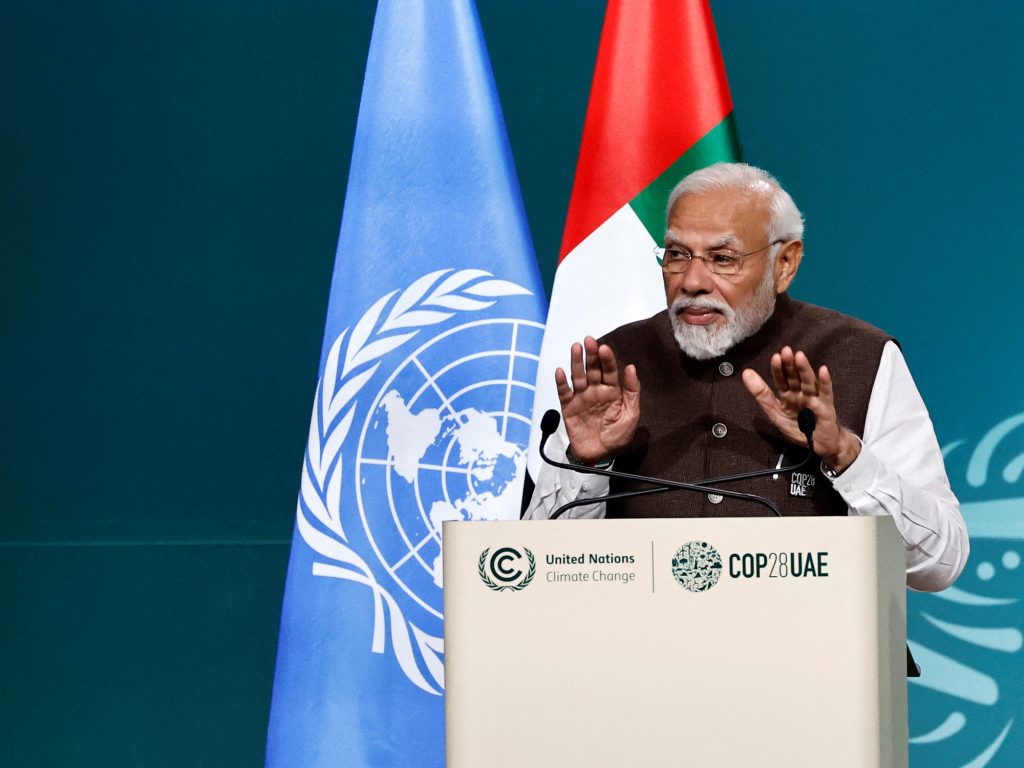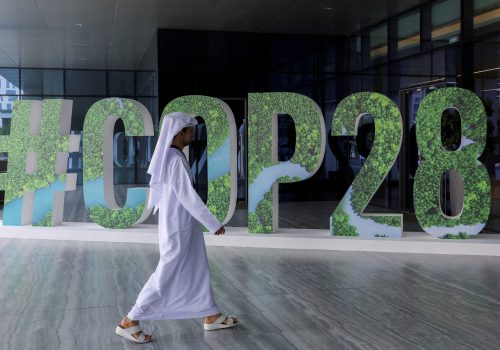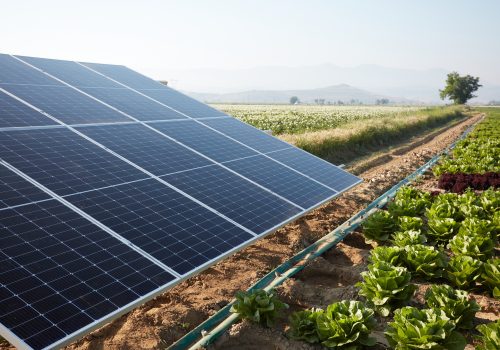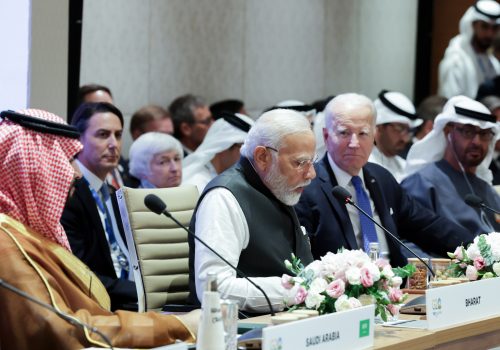As Indian Prime Minister Narendra Modi prepared for a historic visit to Washington, DC this year, Apple CEO Tim Cook made a journey in the other direction: He flew to Mumbai to celebrate Apple’s twenty-five-year presence in the South Asian nation. “I really feel that India is at a tipping point,” Cook declared, joining the ranks of business leaders and economists who have spent the last three decades forecasting that the twenty-first century will belong to India.
If it’s true that this is the “Indian century,” it is not just because the country is now the most populous on Earth and on track to become the world’s largest economy; it is because India will play a central role in the global energy transition.
India’s success in this area will be measured by a few obvious targets: its ability to bring down emissions domestically, the example it sets for how other nations of the Global South can undergo their own successful energy transitions, and India’s ability to partner with other nations on climate solutions.
But there may be another just as important, but less obvious, role for India to play: an unofficial mediator between the United States and China to ensure global international decarbonization targets remain in reach amid intensifying competition. The United Nations (UN) Climate Change Conference, also known as COP28—taking place only months after India hosted the Group of Twenty (G20) Summit in New Delhi—is a good opportunity for India to begin to flex its climate muscles on the world stage.
India’s strides at home
The “Indian century” argument is usually built on two pillars: demography and economics. India’s growing population has already surpassed China’s, and by 2050, 20 percent of the world’s workforce could be Indian. Once projected to be the “world’s second-largest economy,” India is now poised to become the “world’s largest everything.” The past two decades have seen India lift millions out of poverty as it achieved some of the fastest growth rates in the world. But this is just the beginning; the International Monetary Fund foresees India’s economy overtaking Germany and Japan before the end of the decade, the eurozone by 2050, and, if you ask Goldman Sachs, even the United States by 2075.
As a consequence of India’s size and growth, the country is a huge greenhouse gas emitter and currently contributes 7 percent of global emissions. At COP26—which took place in Glasgow, Scotland, in 2021—India surprised everyone by saying it intends to reach net-zero emissions by 2070. Many observers are skeptical about India’s ability to make the domestic changes it needs to reach the lofty target. In a Foreign Affairs article in June, Arunabha Ghosh—chief executive officer of the Council on Energy, Environment, and Water and vice chair of the UN Committee for Development Policy—sounded a hopeful but cautious note on this issue. “India is trying to develop as fast as it can while eliminating greenhouse gas emissions, and traditionally, states cannot develop and decarbonize simultaneously,” he wrote. “[India] will, in other words, have to grow in a manner that no major economy has before.”
Think about it: Combine India’s rapid demographic growth with its economic growth, and one gets the fastest-growing energy demand in the world in the coming decades. As it connects fifty million citizens to the grid each year and ramps up its manufacturing capabilities, India has become the second-largest producer and consumer of coal, which provides more than 70 percent of its power needs. In doing so, it has become the world’s third-largest greenhouse gas emitter. While India has committed to reducing the share of coal in its energy mix, this doesn’t necessarily translate into an absolute decrease in coal consumption. Today, Indians consume a third of the electricity the average individual does, and a twelfth compared to Americans. To close this gap, the Indian government has accelerated coal production. Last year, for example, coal production increased by more than 15 percent. In a February Washington Post interview, Indian Coal Secretary Amrit Lal Meena could not have been more direct: “Our energy needs are first and foremost. . . whatever we produce is consumed. Every coal mine matters.” In international climate negotiations, India’s ambivalent position has dented its climate credibility, in Paris and more recently in Glasgow.
On a more positive note: In 2021 alone, the South Asian giant built up twice as much renewable capacity as coal. Through innovative auctions, India is on track to achieve its target of meeting half of its electricity needs from renewables by 2030. In 2021 alone, India added fourteen gigawatts (GW) of solar capacity, the equivalent of the United Kingdom’s total solar fleet. India has amassed close to seventy GW of solar capacity and forty GW of wind. If India can succeed in meeting economic and population growth with decreasing emissions and cleaner energy, then there is hope the rest of the world can too.
India on the world stage
The above examples, however, are just within India’s borders. India has no choice but to reduce its own emissions, but that alone will not fix its climate problems. Global warming of two degrees Celsius would lead to six times more heatwaves in India and significantly disturb monsoon rains, a phenomenon so important for India’s economy that one Indian leader referred to it as India’s “real finance minister.” These unavoidable facts, combined with India’s historical nonalignment, mean that the country holds the international keys to finding common climate solutions.
India is proving to be an indispensable international partner for the West. As Europe and the United States struggle to find alternative suppliers to China to rebalance their clean industry supply chains, India is developing its own manufacturing capabilities through the “Make in India” plan. More business with India and less with China could be seen as beneficial for Western policymakers and Indian policymakers. Indian and Western policymakers share challenges and objectives: India and most of the West are large net importers of fossil fuels (the notable exception being the United States). They are both ramping up investments in clean energy, and back in 2015, India and France launched an initiative to mobilize one trillion dollars to advance solar power in developing countries. While much was made of security and defense during Modi’s visit to Washington, DC, the joint statement released at the close of the summit placed decarbonization at the forefront, welcoming an investment from India’s VSK Energy that would be directed toward a solar panel factory in the United States, as well as calling for deepened cooperation on energy storage and carbon capture. Europe, meanwhile, has been looking to deepen its ties with India on green hydrogen.
India’s nonalignment policy also lends it credibility with the developing world. India has thus far helped to ensure that both developing and developed nations bring emissions down in a manner that is fair. Historically, India has championed the notion of justice in international climate negotiations, under the principle of “differentiated responsibilities.” India has argued that countries should focus on cumulative historical emissions and emissions per capita, two metrics on which the United States and Europe fare particularly poorly. At COP28, Indian negotiators will be pushing for developed nations to become carbon negative by 2050. Recently, India has played a vocal role in the effort by developing countries to attract more climate funding from rich nations. The pledge made by developed countries at COP15—held in Copenhagen, Denmark, in 2009—to provide one hundred billion dollars per year to developing nations for climate action has been broken every year since.
India as a climate mediator?
Although many major greenhouse gas emitting countries are motivated to reach climate targets by domestic (rather than international) pressure, simmering tensions between the West and the rest could eventually hamper international climate negotiations efforts. This may lead to yet another role for India to play in the global green transition: a mediator to ensure that US-China competition doesn’t derail global climate targets.
India has its own issues with China, of course. The December 2022 clash at the 2,100-mile India-China border (known as the Line of Actual Control), represented the worst breakdown in the relationship since 2020 and created a more heavily militarized border between the two countries. According to the Pew Research Center, India is the only middle-income country where a majority has an unfavorable view of China. Chinese leader Xi Jinping also decided to skip the G20 Summit in New Delhi, most likely because China would rather focus its energy on where it’s a bigger player in the room: the BRICS Plus. India is also working to reduce its own dependencies on China and is cooperating with the United States and its allies in the Indo-Pacific region, a key component of Modi’s visit to Washington this year. The Biden administration has breathed new life into the Quad, a security dialogue among the United States, India, Japan, Australia. Even the India-Middle East-Europe Economic Corridor, announced at this year’s G20 Summit, seems meant to directly compete with China’s Belt and Road Initiative (which is, at the moment, floundering.) And India has its own clean industry rebalancing challenge: China continues to dominate the supply of solar panels in India, and several Indian manufacturers have declared bankruptcy.
But India has also built bridges with China that the West lacks. Both Asian superpowers view coal as strategic, capable of stabilizing grids as renewable energy comes online. They both agree on the push to recognize historical emissions, not only current emissions, and they partake in several fora where the West is absent, such as the BRICS Plus and the Shanghai Cooperation Organization. If any country is capable of speaking with both sides of the US-China divide, it is India.
So how can India become a successful climate mediator?
First, India should be clear that framing the US-India relationship through the lens of competition with China won’t work. The “us or them” approach has not paid off for the United States in the rest of the Global South, and it cannot risk allowing that same approach to fail in India. Up until now, India’s role as a nonaligned middle power seems to have resonated with US policymakers, and there’s been a major diplomatic push from Washington to deepen its relationship with New Delhi. India knows that the United States needs it as a partner in the Indo-Pacific region, so the relationship today is win-win. But it’s up to India to continue to hold its ground against the tendency for the United States to shape most of its relationships through the lens of its competition with China. Nowhere is this more important than in the global energy transition.
Second, India should ensure that the geopolitical rivalry between the United States and China does not derail green technology advancements and emulation. Overly aggressive decoupling from China will fragment global economies and raise the costs of decarbonization when the world can least afford it. Where one has built expertise in a given sector, that expertise should be shared. Europe and India can lead by example in this regard: They have just opened talks for the production and supply of green hydrogen. China’s domination of clean energy supply chains and the US Congress passing the Inflation Reduction Act in 2022 have raised concerns among some experts about unfair trade practices. But India and the West (including the United States) both remain extremely dependent on the rest of the world for their energy transitions, and protectionist measures threaten to choke the large supplies of raw materials, solar panels, and everything else they need to meet their goals.
Third, developing countries need much more climate finance from developed countries to successfully combat the far-reaching effects of global climate change. According to a 2023 analysis by the UN Framework Convention on Climate Change, developing countries’ needs will amount to nearly six trillion dollars by 2030 to meet their Nationally Determined Contributions—measurements that are “at the heart of the Paris Agreement and the achievement of its long-term goals.” Heeding this call and reaching these goals require reforming international climate finance. New ideas were put on the table at the Summit for a New Global Financial Pact in Paris in June, including reforms for multilateral lenders. As Sarang Shidore wrote for Foreign Affairs in August, “Global South states have mostly maintained a united front in demanding more climate financing from their European and North American counterparts.” This is an area where India could take the lead on behalf of the Global South, especially given its proven track record in crowding in private capital for renewable development.
An Indian climate century should be celebrated by the West: A strong India, taking the lead in the fight against climate change, is in everyone’s interest. India, by reaching toward its own climate targets at home, can step up its engagement on the international stage, lead the reform of international climate finance, push cross-border cooperation in vital green technologies, and help to defuse US-China tensions. It may not be the easiest road, but for the good of the international community, it is a necessary one for India to take.
Rachel Rizzo is a nonresident senior fellow at the Atlantic Council’s Europe Center.
Théophile Pouget-Abadie is a nonresident fellow at the Atlantic Council’s Transform Europe Initiative and policy fellow at the Jain Family Institute.
Note: This piece has been updated to remove an outdated reference to negotiations over the loss and damage fund, which was agreed to on November 30.
Further reading
Thu, Nov 30, 2023
Expert analysis: The successes and shortcomings in the fight against climate change at COP28
New Atlanticist By
Our experts dispatched to Dubai, where they analyzed how global leaders responded to the greatest challenges posed by climate change.
Thu, Nov 30, 2023
Public funds alone can’t solve the climate crisis
Global Energy Agenda By
Financing climate action, particularly in the developing world, is absolutely crucial, especially as the window to speed up and scale up investments in solutions rapidly narrows.
Fri, Oct 6, 2023
The India-Middle East Corridor: a Biden Road Initiative?
MENASource By Jean-Loup Samaan
Economists and regional experts expressed their reservations on the feasibility—both politically and financially—of a corridor that would redraw the map of infrastructure across Eurasia.
Image: India's Prime Minister Narendra Modi delivers a national statement at the World Climate Action Summit during the United Nations Climate Change Conference (COP28) in Dubai, United Arab Emirates, on December 1, 2023. Photo via REUTERS/Thaier Al Sudani.



